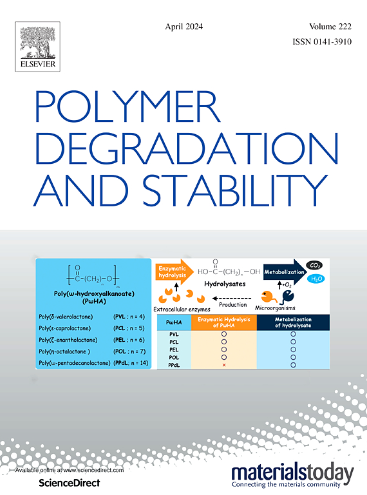氯化植酸三嗪酯共价键对真丝织物进行阻燃改性,提高洗涤耐久性
IF 7.4
2区 化学
Q1 POLYMER SCIENCE
引用次数: 0
摘要
受x型活性染料的启发,本研究以生物质植酸、乙醇胺、氯化三聚氰尿酸为原料,经酯化和亲核取代合成氯化三嗪植酸酯(CTPE)。然后通过易吸附工艺将CTPE应用于真丝织物,以获得阻燃性。系统地研究了改性真丝织物的化学结构、交联机理、阻燃性能、洗涤耐久性、热稳定性和燃烧性能。改性真丝织物具有自熄性,极限氧指数高达33.7%,损伤长度减少了8.7 cm。CTPE和丝绸纤维之间的共价交联确保了FR的耐久性,在20次洗涤循环后保持性能。CTPE改性显著降低了真丝织物的放热率和排烟率,峰值放热率和总排烟率分别降低了49.7%和77.7%。炭渣分析证实了凝态FR机制,而真丝织物的物理性能基本保持不变。本研究提供了一种高效且环保的方法来增强真丝织物的阻燃性,将可持续性与高性能FR功能相结合。本文章由计算机程序翻译,如有差异,请以英文原文为准。

Covalent bonding of chlorinated triazine phytate ester for flame-retardant modification of silk fabric with improved washing durability
Inspired by X-type reactive dyes, this study synthesized the chlorinated triazine phytate ester (CTPE) via esterification and nucleophilic substitution by using biomass phytic acid, ethanolamine, and cyanuric chloride. CTPE was then applied to silk fabrics through the facile adsorption process to impart flame retardancy. The chemical structure, crosslinking mechanism, FR properties, washing durability, thermal stability, and combustion behavior of the modified silk fabrics were systematically investigated. The modified silk fabric exhibited self-extinguishing behavior with a high limiting oxygen index of 33.7 % and a reduced damaged length of 8.7 cm. Covalent crosslinking between CTPE and silk fibers ensured FR durability, maintaining performance after 20 washing cycles. The CTPE modification significantly reduced heat and smoke release of silk fabric, lowering the peak heat release rate and total smoke production by 49.7 % and 77.7 %, respectively. The char residue analyses confirmed a condensed-phase FR mechanism, while the physical properties of silk fabrics remained largely intact. This study provides an efficient and eco-friendly approach to enhancing the flame retardancy of silk fabrics, combining sustainability with high-performance FR functionality.
求助全文
通过发布文献求助,成功后即可免费获取论文全文。
去求助
来源期刊

Polymer Degradation and Stability
化学-高分子科学
CiteScore
10.10
自引率
10.20%
发文量
325
审稿时长
23 days
期刊介绍:
Polymer Degradation and Stability deals with the degradation reactions and their control which are a major preoccupation of practitioners of the many and diverse aspects of modern polymer technology.
Deteriorative reactions occur during processing, when polymers are subjected to heat, oxygen and mechanical stress, and during the useful life of the materials when oxygen and sunlight are the most important degradative agencies. In more specialised applications, degradation may be induced by high energy radiation, ozone, atmospheric pollutants, mechanical stress, biological action, hydrolysis and many other influences. The mechanisms of these reactions and stabilisation processes must be understood if the technology and application of polymers are to continue to advance. The reporting of investigations of this kind is therefore a major function of this journal.
However there are also new developments in polymer technology in which degradation processes find positive applications. For example, photodegradable plastics are now available, the recycling of polymeric products will become increasingly important, degradation and combustion studies are involved in the definition of the fire hazards which are associated with polymeric materials and the microelectronics industry is vitally dependent upon polymer degradation in the manufacture of its circuitry. Polymer properties may also be improved by processes like curing and grafting, the chemistry of which can be closely related to that which causes physical deterioration in other circumstances.
 求助内容:
求助内容: 应助结果提醒方式:
应助结果提醒方式:


